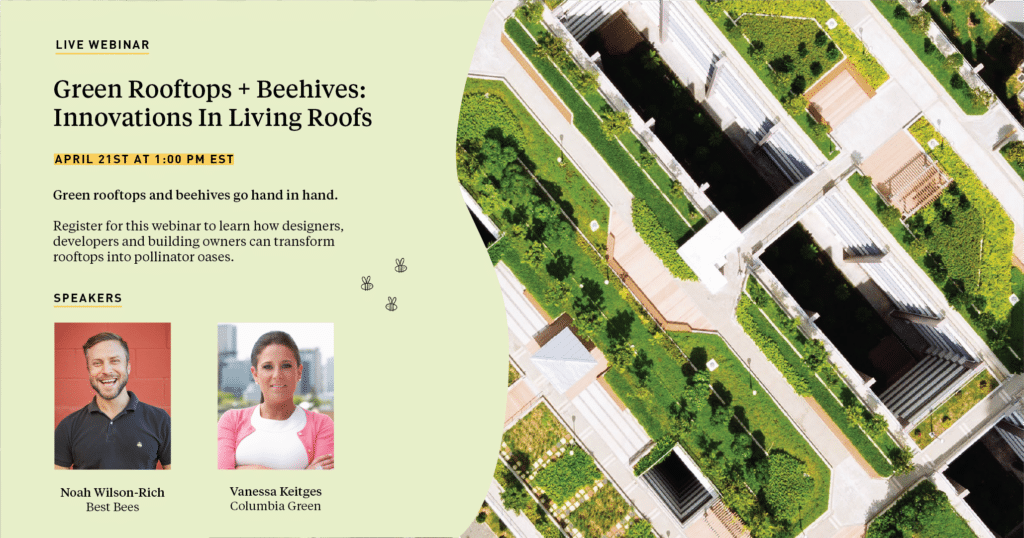In celebration of Earth Day, we held a webinar with Columbia Green Technologies. Together Noah Wilson-Rich and Vanessa Keitges, CEO of Columbia-Green.com did a deep dive into Living Roofs – green roof designs that incorporate honeybee hives. Hundreds of participants joined us – individuals and businesses who want to do more than the status quo, who are really searching for innovations that can help our climate and our world.
There was so much great information shared. ICYMI you can watch it here.
Here are three key takeaways from the session.
Look Up. The Gray to Green Movement is Up On The Roof
If we all just look up, we can see that there are acres and acres of unused real estate that can be turned into lush biodiverse green spaces.
Increasingly, buildings are going from gray to green. People want access to air, light, and nature where they live, work, and play. They are drawn to green spaces. Vanessa calls this Green Envy. This consumer demand is really driving the market.
And it’s making a big difference. Let’s just look at one facet, temperature.
Urban building rooftops are hot. Cooling as an industry consumes up to 30% of global electricity and generates 8% of greenhouse gas emissions worldwide. By 2030, electricity demand for cooling in buildings could rise by as much as 50% globally. The strain on cities will be palpable.
Green roofs are cooler. In summer a green roof can reach 75 degrees, whereas a vacant black tar roof can reach 120 degrees or more. Honeybee colonies are amazing and can thrive on a vacant roof, and in fact many of our urban beehives are on gray or black rooftops. But green is definitely better for bees.
Why would YOU install a living roof?
Our webinar attendees included building owners, developers, designers, and architects. We wanted to know what their primary motivation was for bringing hives and green roofing to their rooftop. So we asked them.
A whopping 84% said the number one reason they have or are considering a green roof with beehives is to mitigate the effects of climate change. The other possible answers ranged from earning green building credits like LEED to policy and mandates, and even to consumer demand.
This response is very encouraging. It indicates a change. Away from policy and toward sustainability. We are encouraged that we are on a path to creating a Virtuous Cycle.
When pollinators are thriving in a community, then the food system is stronger. When our natural environment is thriving, it makes a positive impact on community health and climate justice.
But let’s keep in mind that sustainability can be profitable. In fact, the CEO of Credit Suisse said:
“There is no contradiction of sustainable investments and sustainable returns, quite the opposite actually. In many cases, sustainable investments are actually higher returning than non-sustainable investments.” — Thomas Gottstein CEO Credit Suisse
Using data to improve resiliency and sustainability
In Spring 2020, Best Bees installed two beehives in the beautiful sedum garden that Columbia Green Technologies had installed. Sedum is an ideal plant for rooftop gardens for a variety of reasons. The bees quickly took to the sedum plants and were happily buzzing all around them.
We did a HoneyDNA analysis on the hives at the Chrysler Building. The Best Bees research team had a hypothesis that the Honey DNA results would show that the bees pollinated the sedum and that it was a primary food source. We have found sedum many times in honey DNA.
However, we found almost no trace of sedum in the results – a truly unexpected result.
This example points to how our research helps us better understand what the bees like for their nutrition so that we can respond accordingly.
We feel a strong responsibility to design a more resilient future.
Best Bees and Columbia Green are now collaborating on the next wave of green roof designs. We anticipate new designs that combine sedums with top plants for pollinators in specific, whether in planters or even if they are plugs put directly into the sedums depending on the plant.
We’re encouraged by the companies and real estate properties who are committed to turning underutilized spaces into leveraged assets to add real value for their stakeholders and their bottom lines.
Check out the webinar to get more great information about:
- The ways cities are vibrant environments for pollinators
- How green roofs mitigate the significant threats from stormwater overflow
- Economic benefits including lower long term costs.






